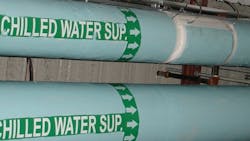With $85 million to invest in expansion, including $25 million from the U.S. Department of Energy to start the first solar-development laboratory in the country, SVTC (formerly Silicon Valley Technical Center) was looking to expand its facility in San Jose, Calif., by 30,000 sq ft, including a 12,000-sq-ft cleanroom. Because the building was constructed during the 1980s, before metering and submetering became common, SVTC did not know how much more infrastructure capacity was needed.
SVTC turned to Advance Design Consultants Inc. (ADC) of San Jose for a solution.
“We told SVTC we could meter their pipes, datalog the flow measurements, and calculate the percentage of capacity they were at for their HVAC systems and other compressors,” Jason DuBose, vice president of engineering and operations for ADC, said. “The only restriction was we couldn’t use intrusive metering devices because of the cleanroom environment. That created a problem because we would be measuring gas as well as fluids. I knew we could use ultrasonic clamp-on meters to measure fluids, but didn’t know of a non-intrusive meter for gases.”
DuBose then learned of non-intrusive ultrasonic gas-flow meters from FLEXIM AMERICAS Corp.
Benefits of Ultrasonic
Unlike traditional meters, ultrasonic flow meters contain no moving parts and do not require frequent calibration and maintenance. Measurements are made using the transit-time-difference method.
The transmission speed of an ultrasonic signal depends on the flow velocity of the carrier medium; a signal moves slower against the flow of a carrier medium and faster with it. In obtaining a measurement, two ultrasonic pulses are sent through a medium—one in the direction of flow and the other against it. The meter’s transducers work alternately as emitter and receiver. The transit time of the signal sent in the direction of flow is shorter than the transit time of the signal sent against it. The meter measures the difference and calculates average flow velocity.
Because ultrasound signals propagate in solids, an ultrasonic meter can be mounted directly onto a pipe.
FLEXIM ultrasonic flow meters are not affected by density, which makes them well-suited for applications from slurries to gas. They automatically compensate for variations in viscosity.
Gathering Data
DuBose called FLEXIM Flow Measurement Service (FMS).
“I assured him we could measure the gases as well as the fluids with equal accuracy,” David Gorshe, field-service engineer for FLEXIM FMS, said.
FMS was developed by FLEXIM to provide non-intrusive flow measurement to customers not in need of their own metering system. It uses FLEXIM ultrasonic meters and technology to acquire flow data and pass it on to the client or engineering firm for analysis.
“We confirm and certify flow rates of new and existing equipment, measure volume, perform BTU measurement, perform NIST- (National Institute of Standards and Technology-) certified calibration, and provide formal reports and data analysis based on NIST-traceable portable reference meters,” Gorshe said. “In the case of SVTC, we were strictly data gatherers. ADC did the analysis and provided the reports.”
Gorshe and his team needed only four days to gather data for the SVTC facility.
“We went in with four meters,” Gorshe said, “set them up for either 24 or 48 hr, depending on the data needed, went back in, and moved them. Done in four days and handed the collected data to the ADC team for analysis.”
DuBose added: “It worked out well for SVTC. It turned out they weren’t as close to capacity as they had thought. In most cases, they had enough capacity to cover the expansion. They would have to replace aging equipment and perform some upgrades and retrofits, but no major new investments. This project more than paid for itself.”
Jack Sine is a freelance writer specializing in the HVAC marketplace. He can be reached at [email protected] or 845-831-6578.
For Design Solutions author guidelines, call Scott Arnold, executive editor, at 216-931-9980, or write to him at [email protected].
